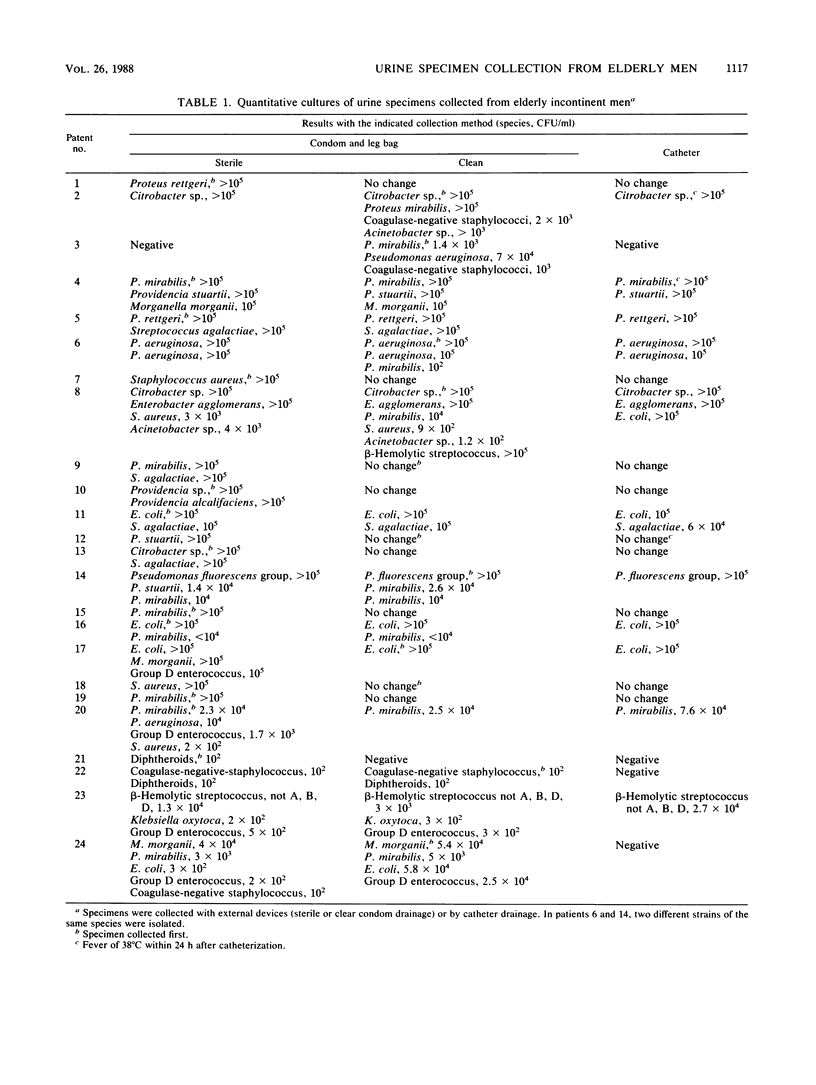Abstract
We determined the validity of using external devices for urine specimen collection from 24 elderly incontinent men residing in a nursing home by collecting three sequential specimens, two with external devices and then one by catheterization. The positive predictive value of organisms isolated in quantitative counts of greater than or equal to 10(5) CFU/ml in external devices for bladder bacteriuria was 86% for either sterile or clean collecting devices and 93% for the same organism in two consecutive specimens. The negative predictive value for organisms present in quantitative counts of less than 10(5) CFU/ml was 90% for both sterile and clean devices and 86% when the organism was present in both specimens. Contamination in external collection devices was not influenced by whether the device was clean or sterile, circumcision of the resident, or duration of time between device application and specimen collection. These data suggest that urine specimens collected by ward nursing staff with external devices are reliable for the diagnosis of bacteriuria in this patient population.
Full text
PDF




Selected References
These references are in PubMed. This may not be the complete list of references from this article.
- Fierer J., Ekstrom M. An outbreak of Providencia stuartii urinary tract infections. Patients with condom catheters are a reservoir of the bacteria. JAMA. 1981 Apr 17;245(15):1553–1555. [PubMed] [Google Scholar]
- Gleckman R., Blagg N., Hibert D., Hall A., Crowley M., Pritchard A., Warren W. Community-acquired bacteremic urosepsis in the elderly patients: a prospective study of 34 consecutive episodes. J Urol. 1982 Jul;128(1):79–81. doi: 10.1016/s0022-5347(17)52764-0. [DOI] [PubMed] [Google Scholar]
- Harding G. K., Marrie T. J., Ronald A. R., Hoban S., Muir P. Urinary tract infection localization in women. JAMA. 1978 Sep 8;240(11):1147–1151. [PubMed] [Google Scholar]
- Jewett M. A., Fernie G. R., Holliday P. J., Pim M. E. Urinary dysfunction in a geriatric long-term care population: prevalence and patterns. J Am Geriatr Soc. 1981 May;29(5):211–214. doi: 10.1111/j.1532-5415.1981.tb01768.x. [DOI] [PubMed] [Google Scholar]
- Kaye D. Urinary tract infections in the elderly. Bull N Y Acad Med. 1980 Mar;56(2):209–220. [PMC free article] [PubMed] [Google Scholar]
- Nicolle L. E., Bjornson J., Harding G. K., MacDonell J. A. Bacteriuria in elderly institutionalized men. N Engl J Med. 1983 Dec 8;309(23):1420–1425. doi: 10.1056/NEJM198312083092304. [DOI] [PubMed] [Google Scholar]
- Ouslander J. G., Greengold B. A., Silverblatt F. J., Garcia J. P. An accurate method to obtain urine for culture in men with external catheters. Arch Intern Med. 1987 Feb;147(2):286–288. [PubMed] [Google Scholar]
- Ouslander J. G., Kane R. L., Abrass I. B. Urinary incontinence in elderly nursing home patients. JAMA. 1982 Sep 10;248(10):1194–1198. [PubMed] [Google Scholar]
- WOLFSON S. A., KALMANSON G. M., RUBINI M. E., GUZE L. B. EPIDEMIOLOGY OF BACTERIURIA IN A PREDOMINANTLY GERIATRIC MALE POPULATION. Am J Med Sci. 1965 Aug;250:168–173. doi: 10.1097/00000441-196508000-00007. [DOI] [PubMed] [Google Scholar]


